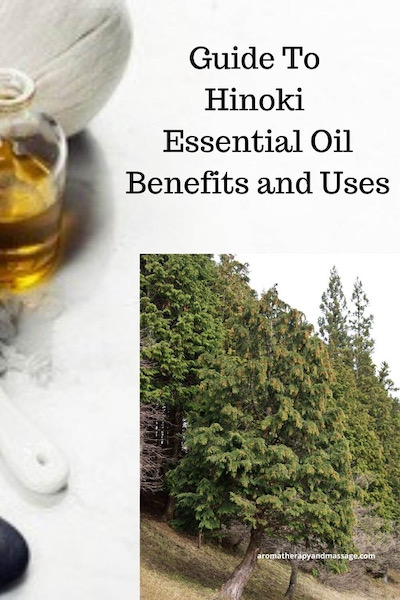- Home
- Essential Oil Profiles
- Hinoki Essential Oil
As an affiliate for Bookshop, Amazon, and other programs, I may earn a small commission for products purchased through links. This doesn't affect the price you pay. Privacy policy and disclosures.
Search this site:
Guide to Hinoki Essential Oil Benefits and Uses
Hinoki essential oil (Chamaecyparis obtusa) can be distilled from the wood, roots, or needles (leaves) of the tree (or possibly a blend of all three). The chemistry and actions of the three types of oil are slightly different.
Also called Japanese cypress or hinoki cypress, the tree is native to Japan, where it's protected. However, the tree is now widely cultivated in temperate areas of the northern hemisphere. The wood is valuable in building palaces, temples, and shrines.
Basic Hinoki Facts
Plant family: Cupressaceae
Production: Hinoki wood is steam distilled from wood chips; hinoki leaf is steam distilled from the needles. A root oil is steam distilled from the tree's roots.
Aroma: The wood oil has a dry, woody scent with a sweet, slightly spicy undertone. The aroma varies between the wood, root and needle (leaf) oils.
Perfume/Aromatic note: Middle.
Is hinoki safe to use during pregnancy? Consult a professional.
Is hinoki essential oil safe for children? Yes, over age 2.
Cautions: None known.
Main components:
Hinoki Wood
- alpha-cadinol
- t-muurolol
- gamma-cadinene
- omega-cadinene
Hinoki Leaf
- elemol
- alpha-terpinyl acetate
- gamma-eudesmol
- bornyl acetate
Hinoki Root
- longi-a-nojigiku alcohol
- alpha-terpinyl acetate
- longi-beta-camphenilan aldehyde
- t-cadinol
Source: Essential Oil Safety, 2nd Edition
Hinoki Essential Oil Benefits and Uses
The Complete Guide to Clinical Aromatherapy: Hinoki helps relieve pain and inflammation, eliminate odors, and reduce candida and athlete's foot. The oil also acts as an insect repellent and has meditative benefits.
Stillpoint Aromatics: Hinoki helps reduce stress and anxiety, fight fungus, relieve sinus congestion and respiratory issues, protect against insects, and heal rashes, cuts, abrasions, and minor skin irritations. The essential oil also offers spiritual protection and is great for meditation and connecting to your higher self. The oil is calming, can help clear the mind, and can clear a room of negative energy.
Jeanne Rose: Hinoki oil helps heal minor cuts, scrapes, wounds, sores, pimples, pustules, and skin eruptions. Use the oil in a face mask to calm or moisturize the skin, for a spot treatment, to remove makeup, as a skin-conditioner, or in a cleansing water or toner.
Use hinoki leaf oil in inhalation blends for to calm and soothe stress. For diffusion, this oil blends best with citrus essential oil. Hinoki essential oil can scent products ranging from skincare to deodorants and soaps. The root oil repels insects.
Revive Oils: Hinoki works well for skin cleansing applications and also may reduce respiratory congestion and open sinuses. Emotionally, this essential oil reduces feelings of stress and anxiety while also promoting a positive mood. You can also use the oil as a natural insect repellent. Suggested hinoki uses:
- To clear congested airways: Blend the essential oil with a carrier oil and rub onto your chest as needed.
- To create a relaxing and calming atmosphere: Diffuse the oil (alone or with a citrus oil).
- To help cleanse skin and reduce inflammation: Add a drop of the oil to your natural face cleanser.
Salvatore Battaglia: In Traditional Chinese Medicine, hinoki wood oil strengthens the Lungs and balances the metal element. Use the oil in a blend to help relieve colds and flu, chronic cough, excessive phlegm, and sinus congestion.
Use hinoki to reduce stress, anxiety, and nervous tension. The oil promotes a calming and relaxing atmosphere that nurtures spiritual awareness. The scent dispels negativity, promotes spiritual calmness and tranquillity, and has a subtle grounding effect that stabilizes energy. The oil also repels insects.
Suggested essential oils to blend with hinoki wood:
- To help relieve the symptoms of colds or flu: niaouli, myrtle, peppermint, pine, black spruce, or tea tree.
- To reduce stress, nervous tension, and anxiety: bergamot, geranium, lavender, sweet orange, or sweet marjoram.
- To promote confidence and self-esteem: atlas cedarwood, black pepper, ginger, pine, rosemary, or black spruce.
- To promote inner calm and harmony: atlas cedarwood, bergamot, clary sage, or lavender.
- For meditation to strengthen spiritual awareness: frankincense, lemon, myrrh, patchouli, sandalwood, or vetiver.
Buy essential oils from Aromatics International (recommended).
Rocky Mountain Essential Oils.
Photo Credit: Σ64 - Own work, CC BY 3.0, via Wikimedia Commons




